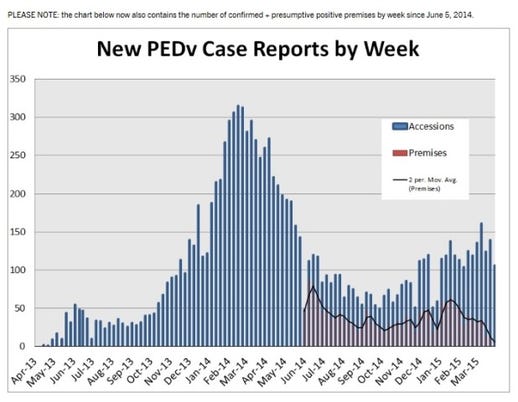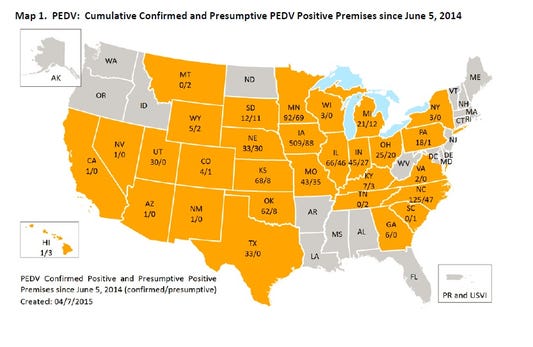Virus worldwide still concern, U.S. PEDV spike but still at lower level

Porcine epidemic diarrhea virus lingers as a risk to hog herds in the U.S. and other parts of the world. A combination of management practices from disease control measures, vaccination protocols and biosecurity has thus far kept the virus outbreak at a much lower level than the previous two years.
Over the past two years, at least 8 million pigs or approximately 10% of the U.S. hog population were killed by PEDV and caused significant economic losses.
Still, elimination of the virus will only remain at the top of the wish list as the virus has disappeared and re-emerged for the last three decades worldwide. For now the U.S hog industry will not let its guard down on the fight against PEDV and other viruses that spread globally.
On March 30, the Harbin Institute of Veterinary Medicine under the Chinese Academy of Agricultural Sciences announced the availability of China’s first domestically-developed triple vaccine for swine to farmers in Heilongjiang province. The live vaccine protects against three common diseases afflicting hog farms across north China: porcine transmissible gastroenteritis, PEDV and porcine rotavirus (G-type).
The USDA granted the first conditional license for PEDV vaccine to Harrisvaccines in June 2014 and is currently available for all U.S. hog producers.
Current PEDV status in U.S.
According to the weekly USDA’s Swine Enteric Coronavirus Disease report, new PEDV cases reported this year have yet to reach last year’s peak.

Nevertheless, the number of accessions has climbed since last fall's low levels. As of last week, PEDV positive cases for this year have totaled 1,626 and currently 34 states have at least one confirmed cases.

Over the past two weeks, the number of PEDV positive cases has jumped from 17 per week to 48 per week. For the week ending April 4, the total premises with confirmed positive status at 1,138 with increase in North Carolina and Iowa being reported.
Since the Federal Order on June 5, 2014; producers, veterinarians and diagnostic laboratories are required to report all cases of novel SECD to USDA or state animal health officials. In addition, the USDA Veterinary Services swine health team publishes weekly report which includes confirmed SECD-infected premises and SECD laboratory testing results data information. One sample received at the laboratory for testing can represent one pig or entire herd.
For the USDA's weekly situation report, click here.
About the Author(s)
You May Also Like



